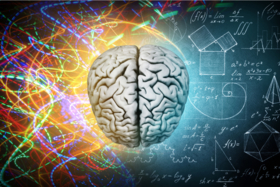How to test spatial thinking

Psychologists who study the patterns of perception have revealed that spatial orientation and spatial thinking develop differently in people living in the mountains and in the valley. Those who are accustomed to look down from the slopes of the mountains well define the size of objects below, but they confuse the sizes of objects located along the horizon.
And vise versa, the inhabitants of the valleys are mistaken about the size, looking from a height, but they are accurate in their estimates of the distances on the flat terrain. These observations confirm that spatial skills develop naturally in the course of human acquisition of relevant experience.
As they grow older, the skill of spatial perception of the surrounding world develops into the ability to represent three-dimensional structures and objects in space and mentally manipulate them. Spatial thinking is a prerequisite for logical thinking and skills to operate with numbers and sizes. The study of geometry in the school is directed not to make the children mathematicians but to develop this particular ability.
A person with a developed spatial intelligence copes easier with many professional and life tasks.
Without spatial thinking, it will not be possible to successfully perform an activity of:
• artist;
• designer;
• architect;
• design engineer;
• process engineer;
• logistics specialist (both transport and warehouse).
The list is quite long. And in everyday life this quality will allow:
- to help your dishwasher;
- to deal with the map of the area and, without resorting to the navigator, get to the right place.
And the meaning of phrases like “the store nearest to the house” or “on the left side of the street” would be completely incomprehensible without this cognitive ability of our brain.
Do you tend to have difficulty performing the following tasks:
• load the trunk of the car as completely as possible;
• calculate exactly the size of the parking space and park successfully;
• navigate in unfamiliar areas, clearly presenting how this place looked on the map;
• understand the mirror image of objects in the room;
• arrange new furniture in a given space without its multiple movements around the room?
If you feel that you are not the best at solving these and similar tasks, then you should pay attention to special training of spatial thinking. By the way, traditionally it is believed that men have better developed spatial thinking and orientation over large distances, while women have better ability to navigate in a small space. This is where the advice of psychologists comes from: "If you have lost a thing at home, ask a woman for help, and if you get lost on the street, ask the man for a way."
Spatial intelligence is based on two mental abilities, it is:
- ability to spatial visualization, i.e. imagination, which allows to build spatial images in consciousness;
- spatial thinking, i.e. the process of mental manipulation of these images.
How can I find out about my spatial abilities
The first and easiest way is self-observation. Try to visualize your room. The more details you can recreate, the better your spatial visualization skills are. Now mentally rotate this room, for example, 90 degrees relative to yourself. The easier you can mentally rotate or change the location of the room, the better your spatial thinking is.
What are your spatial orientation skills? Are different ways of calculating easy for you?
• distances;
• coordinate systems;
• two and three dimensions;
• latitude and longitude?
The space also includes the relative position of objects in relation to each other, the concepts of adjacency, intersections and regions that are either quite far from each other or quite close. How confident are you using these concepts? How easily do you reproduce the representation of objects in space? Do you use
• characters;
• graphic images;
• points, lines;
• arrows
in your activities to represent how objects are represented in space?
How do you master different ways of thinking about distances and interconnections of objects? Can you extrapolate and interpolate? Are you sure that you understand such concepts as atmosphere,
• lithosphere,
• hydrosphere,
• geosphere.
• biosphere?
Further, assessing your experience and skills, how would you answer the following questions:
Can you, based on a three-dimensional drawing of any part, imagine what the piece will look like?
Can you make a simple thing according to the drawing?
If you had to deal with a malfunction in the engine, how confidently would you deal with this situation? If you are fond of cooking and making complex dishes, can you imagine in advance how it will look?
The second way is to compare yourself to others. Compare your success in activities that require spatial skills to the success of your friends and acquaintances. Can you say with confidence that you are not worse, and maybe even better than others, that you can cope with such things as, for example:
- construction of sand castles on the beach;
- modeling of figures from clay;
- search for and frame of setting and composition when photographing;
- technical drawing;
- chess and draughts;
- 3D-modeling, where the ability to manipulate forms is required;
- computer games;
- terrain orientation with a compass and a map.
And finally, the third way - the implementation of test tasks. Similar tasks are found in almost all tests of intelligence assessment. Most often, the task represents the choice of the "correct" sweep, which would correspond to the test figure. To solve this task, you should mentally fold the scan and make sure that its three-dimensional image is the given pattern.
Recently, a lot of various special computer tests for the assessment of visual-spatial intelligence have appeared. They require to deal with the tasks, that are connected with the need to mentally rotate, move, resize and connect together the images or their elements. Such 3D puzzles require the ability of a person to manipulate without the use of hands, but only in his imagination.
You can also try your strength not in special tasks, but in a variety of exercises that require spatial thinking. For example, spatial thinking games will tell you a lot. Do you enjoy such popular entertainment as
- Rubik's cube (by the way, today it is recognized as almost the perfect method of training spatial thinking);
- puzzles;
- Tetris?
How to test spatial thinking using computer diagnostics
Do you want to learn more about your spatial thinking? Then try yourself on the Wikium website and complete the spatial thinking tasks offered there. At first glance, quite simple and even funny in their own way, they, nevertheless, with a sufficient degree of accuracy will show you your level of spatial thinking.
Start with the Polygons simulator and try to evaluate your skill of recognizing the position of a test piece with the “information noise” background. The simulator "Similar Pictures", where you need to track changes quickly, will enthrall you so that you forget about diagnostics.
Simulators “Turn”, “Make a square” and “Geometry” are more complex and are designed for already formed spatial thinking and spatial representations. We will have to recall the good old stereometry in order to answer the question of whether the figures after the turn in the “Turn” task coincide and mentally make a square from the elements in the “Make a square” task. This will require the skill of spatial orientation and retention in memory of the location of the figures and the direction of its sides.
Perhaps, from the first time exercises will seem unusually difficult. But after all, spatial thinking is a very complex cognitive process, based on mental logical manipulation with images and structures.
Recent studies have shown that ...
... spatial thinking with all its complexity can successfully be developed throughout a person’s life. Although traditionally developmental exercises are offered to children of different ages, adults can also hope to get good results after appropriate training.
A review of 217 scientific studies conducted by a group of scientists under the guidance of professor of psychology D. Uttal confirmed that people of all ages can improve almost all known types of spatial skills with the help of training. This important remark brought an end to the long debate about the benefits of learning spatial thinking of people of mature age. One of the successful methods of this type of training was educational video games and computer simulators.











